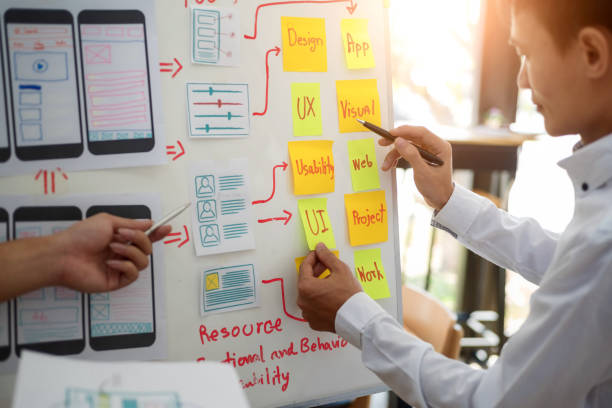
As with the creation of any product, software development takes place over several phases or stages. The process is called the software development life cycle (SDLC) and applies to all types of software, including custom application development services.
SLDC can be defined as a structured software development process that creates a framework for developers to design, create, and deliver the final product. The final product is high-quality software that perfectly meets the client’s requirements.
How Does The Software Development Cycle Work?
There isn’t a project in the world that starts with planning, so that’s where the cycle starts.
Phase 1: Requirement Collection And Analysis
Clients know what they want; the end picture. They approach software development companies with this idea in mind. This starts the planning stage, where the companies create groups that work with clients to nail down the software requirements. The groups create plans or roadmaps that reveal the extent of the projects and troubleshoot potential challenges.
It’s important to use as much detail as possible to avoid confusing ambiguity or duplication of tasks. The design plans also identify achievable milestones along the way. Detail also enables the teams to create realistic timeframes (broken into modules or units) and costs.
Phase 2: Design
Using the roadmap, the software development team creates a couple of documents that drill down further into the requirements to fill out the minute details.
The two documents contain details of the high-level design phase (HLD) and low-level design phase (LLD) that are part of the actual development phase.
| HLD | LLD |
| 1) Descriptions and names for modules. | 1) Modules’ functional logic. |
| 2) Outline each module’s functionality. | 2) Database tables with type and size. |
| 3) Interface relationship between modules. | 3) Details that create the complete framework. |
| 4) Database tables with critical elements. | 4) Locates and resolves dependency issues. |
| 5) Complete architecture diagrams with tech details. | 5) Lists of error messages. |
| 6) Each module’s inputs and outputs. |
Additional features of the software design process include code guidelines, tools, practices, and runtimes that clearly define the project’s pecs and goals.
Phase 3: Development
The development teams begin coding the software development project. The groups begin coding according to the predefined guidelines, including the programming language. They complete development and then send it to the next phase in the cycle, the testing phase.
Phase 4: Testing
The software is sent to the testing team, where it’s tested as a fully integrated product. The purpose is to ensure it meets all of the client’s requirements and to identify any bugs in the system. It’s sent back to the developers, who address the problems and then send it to the testing stage again.
This mini-cycle continues until the quality assurance testers are happy the product meets all of the project requirements.
Phase 5: Deployment
Once it’s passed the quality assurance checks, it’s ready for the deployment phase. Deployment is carried out according to the software deployment strategy.
Phase 6: Maintenance
Deployment isn’t the last phase of the development process. The maintenance phase is ongoing. It’s required to identify and fix bugs that may crop up, install upgrades as they become available, and add features to improve functioning and user-friendliness.
The Software Development Life Cycle Testing Models Improve Services
There are several types of testing models that help software developers improve the quality of their work and assist with ongoing maintenance. Testing models can be applied at any stage during the SDLC, which helps detect problems quickly so they can be fixed before they become exponentially worse.
Some testing models include the following:
Waterfall Model
The waterfall model is one of the oldest testing modules, but it appears to be making way for newer, more efficient models. Briefly, The waterfall model is a linear process; one phase must be completed before another can begin. It’s a rigid model that only allows for testing once the entire software project is complete.
This means problems are only really picked up at the end of development, and it can be a long, laborious, and expensive process to repair them.
Iterative And Incremental Model
In the iterative model, the project is divided into units, which can be divided into even smaller units if necessary. The units can be worked on simultaneously, and each unit undergoes its own testing process. If issues are identified quickly, they can be immediately addressed.
Briefly, the iterative process is a series of small waterfall cycles where the cycle is repeated until its optimally functional. Each version is based on the adjustments and lessons learned from the previous one. This is significantly more cost-efficient and less time-consuming than the waterfall model.
Agile Model
The agile approach to development is similar to the iterative model in that is project is divided into small units which are worked on independently. They also go through the cycle of testing and repair, where each version improves on the previous phases.
Spiral Model
The spiral planning model is known as a risk-driven model. It contains elements of one or several of the other testing methods, effectively adopting the best of each. The result is rapid prototyping and concurrency in the design and development processes.
Laminar’s Custom Application Development Services Use Phases To Provide High-Quality Software
Unlike the waterfall module, SDLC phases don’t have to follow the sequential model or be inflexible. You can go back to any software development steps if you need to adjust or adapt the plan to accommodate unanticipated events that disrupt or derail the development process.Laminar Consulting ensures each step of our process passes even the most rigid quality assurance test. If you need custom mobile applications, get in touch with Laminar at (888) 531-9995 now!
Share this Article:



